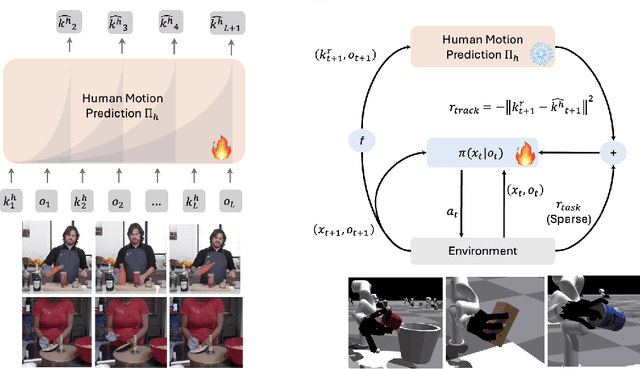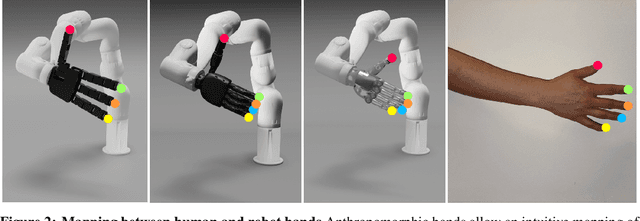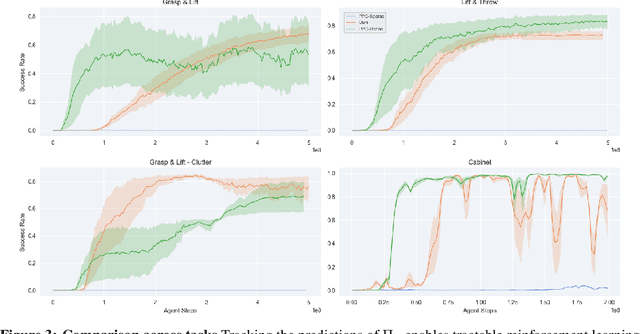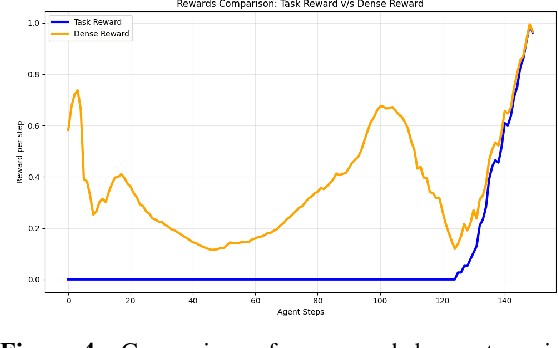Jitendra Malik
Coordinated Humanoid Manipulation with Choice Policies
Dec 31, 2025Abstract:Humanoid robots hold great promise for operating in human-centric environments, yet achieving robust whole-body coordination across the head, hands, and legs remains a major challenge. We present a system that combines a modular teleoperation interface with a scalable learning framework to address this problem. Our teleoperation design decomposes humanoid control into intuitive submodules, which include hand-eye coordination, grasp primitives, arm end-effector tracking, and locomotion. This modularity allows us to collect high-quality demonstrations efficiently. Building on this, we introduce Choice Policy, an imitation learning approach that generates multiple candidate actions and learns to score them. This architecture enables both fast inference and effective modeling of multimodal behaviors. We validate our approach on two real-world tasks: dishwasher loading and whole-body loco-manipulation for whiteboard wiping. Experiments show that Choice Policy significantly outperforms diffusion policies and standard behavior cloning. Furthermore, our results indicate that hand-eye coordination is critical for success in long-horizon tasks. Our work demonstrates a practical path toward scalable data collection and learning for coordinated humanoid manipulation in unstructured environments.
Tracking by Predicting 3-D Gaussians Over Time
Dec 30, 2025Abstract:We propose Video Gaussian Masked Autoencoders (Video-GMAE), a self-supervised approach for representation learning that encodes a sequence of images into a set of Gaussian splats moving over time. Representing a video as a set of Gaussians enforces a reasonable inductive bias: that 2-D videos are often consistent projections of a dynamic 3-D scene. We find that tracking emerges when pretraining a network with this architecture. Mapping the trajectory of the learnt Gaussians onto the image plane gives zero-shot tracking performance comparable to state-of-the-art. With small-scale finetuning, our models achieve 34.6% improvement on Kinetics, and 13.1% on Kubric datasets, surpassing existing self-supervised video approaches. The project page and code are publicly available at https://videogmae.org/ and https://github.com/tekotan/video-gmae.
Diffusion Forcing for Multi-Agent Interaction Sequence Modeling
Dec 19, 2025Abstract:Understanding and generating multi-person interactions is a fundamental challenge with broad implications for robotics and social computing. While humans naturally coordinate in groups, modeling such interactions remains difficult due to long temporal horizons, strong inter-agent dependencies, and variable group sizes. Existing motion generation methods are largely task-specific and do not generalize to flexible multi-agent generation. We introduce MAGNet (Multi-Agent Diffusion Forcing Transformer), a unified autoregressive diffusion framework for multi-agent motion generation that supports a wide range of interaction tasks through flexible conditioning and sampling. MAGNet performs dyadic prediction, partner inpainting, and full multi-agent motion generation within a single model, and can autoregressively generate ultra-long sequences spanning hundreds of v. Building on Diffusion Forcing, we introduce key modifications that explicitly model inter-agent coupling during autoregressive denoising, enabling coherent coordination across agents. As a result, MAGNet captures both tightly synchronized activities (e.g, dancing, boxing) and loosely structured social interactions. Our approach performs on par with specialized methods on dyadic benchmarks while naturally extending to polyadic scenarios involving three or more interacting people, enabled by a scalable architecture that is agnostic to the number of agents. We refer readers to the supplemental video, where the temporal dynamics and spatial coordination of generated interactions are best appreciated. Project page: https://von31.github.io/MAGNet/
Large Video Planner Enables Generalizable Robot Control
Dec 17, 2025Abstract:General-purpose robots require decision-making models that generalize across diverse tasks and environments. Recent works build robot foundation models by extending multimodal large language models (MLLMs) with action outputs, creating vision-language-action (VLA) systems. These efforts are motivated by the intuition that MLLMs' large-scale language and image pretraining can be effectively transferred to the action output modality. In this work, we explore an alternative paradigm of using large-scale video pretraining as a primary modality for building robot foundation models. Unlike static images and language, videos capture spatio-temporal sequences of states and actions in the physical world that are naturally aligned with robotic behavior. We curate an internet-scale video dataset of human activities and task demonstrations, and train, for the first time at a foundation-model scale, an open video model for generative robotics planning. The model produces zero-shot video plans for novel scenes and tasks, which we post-process to extract executable robot actions. We evaluate task-level generalization through third-party selected tasks in the wild and real-robot experiments, demonstrating successful physical execution. Together, these results show robust instruction following, strong generalization, and real-world feasibility. We release both the model and dataset to support open, reproducible video-based robot learning. Our website is available at https://www.boyuan.space/large-video-planner/.
FoundationMotion: Auto-Labeling and Reasoning about Spatial Movement in Videos
Dec 11, 2025Abstract:Motion understanding is fundamental to physical reasoning, enabling models to infer dynamics and predict future states. However, state-of-the-art models still struggle on recent motion benchmarks, primarily due to the scarcity of large-scale, fine-grained motion datasets. Existing motion datasets are often constructed from costly manual annotation, severely limiting scalability. To address this challenge, we introduce FoundationMotion, a fully automated data curation pipeline that constructs large-scale motion datasets. Our approach first detects and tracks objects in videos to extract their trajectories, then leverages these trajectories and video frames with Large Language Models (LLMs) to generate fine-grained captions and diverse question-answer pairs about motion and spatial reasoning. Using datasets produced by this pipeline, we fine-tune open-source models including NVILA-Video-15B and Qwen2.5-7B, achieving substantial improvements in motion understanding without compromising performance on other tasks. Notably, our models outperform strong closed-source baselines like Gemini-2.5 Flash and large open-source models such as Qwen2.5-VL-72B across diverse motion understanding datasets and benchmarks. FoundationMotion thus provides a scalable solution for curating fine-grained motion datasets that enable effective fine-tuning of diverse models to enhance motion understanding and spatial reasoning capabilities.
OSMO: Open-Source Tactile Glove for Human-to-Robot Skill Transfer
Dec 09, 2025Abstract:Human video demonstrations provide abundant training data for learning robot policies, but video alone cannot capture the rich contact signals critical for mastering manipulation. We introduce OSMO, an open-source wearable tactile glove designed for human-to-robot skill transfer. The glove features 12 three-axis tactile sensors across the fingertips and palm and is designed to be compatible with state-of-the-art hand-tracking methods for in-the-wild data collection. We demonstrate that a robot policy trained exclusively on human demonstrations collected with OSMO, without any real robot data, is capable of executing a challenging contact-rich manipulation task. By equipping both the human and the robot with the same glove, OSMO minimizes the visual and tactile embodiment gap, enabling the transfer of continuous shear and normal force feedback while avoiding the need for image inpainting or other vision-based force inference. On a real-world wiping task requiring sustained contact pressure, our tactile-aware policy achieves a 72% success rate, outperforming vision-only baselines by eliminating contact-related failure modes. We release complete hardware designs, firmware, and assembly instructions to support community adoption.
SPIDER: Scalable Physics-Informed Dexterous Retargeting
Nov 12, 2025Abstract:Learning dexterous and agile policy for humanoid and dexterous hand control requires large-scale demonstrations, but collecting robot-specific data is prohibitively expensive. In contrast, abundant human motion data is readily available from motion capture, videos, and virtual reality, which could help address the data scarcity problem. However, due to the embodiment gap and missing dynamic information like force and torque, these demonstrations cannot be directly executed on robots. To bridge this gap, we propose Scalable Physics-Informed DExterous Retargeting (SPIDER), a physics-based retargeting framework to transform and augment kinematic-only human demonstrations to dynamically feasible robot trajectories at scale. Our key insight is that human demonstrations should provide global task structure and objective, while large-scale physics-based sampling with curriculum-style virtual contact guidance should refine trajectories to ensure dynamical feasibility and correct contact sequences. SPIDER scales across diverse 9 humanoid/dexterous hand embodiments and 6 datasets, improving success rates by 18% compared to standard sampling, while being 10X faster than reinforcement learning (RL) baselines, and enabling the generation of a 2.4M frames dynamic-feasible robot dataset for policy learning. As a universal physics-based retargeting method, SPIDER can work with diverse quality data and generate diverse and high-quality data to enable efficient policy learning with methods like RL.
Deep Sensorimotor Control by Imitating Predictive Models of Human Motion
Aug 26, 2025



Abstract:As the embodiment gap between a robot and a human narrows, new opportunities arise to leverage datasets of humans interacting with their surroundings for robot learning. We propose a novel technique for training sensorimotor policies with reinforcement learning by imitating predictive models of human motions. Our key insight is that the motion of keypoints on human-inspired robot end-effectors closely mirrors the motion of corresponding human body keypoints. This enables us to use a model trained to predict future motion on human data \emph{zero-shot} on robot data. We train sensorimotor policies to track the predictions of such a model, conditioned on a history of past robot states, while optimizing a relatively sparse task reward. This approach entirely bypasses gradient-based kinematic retargeting and adversarial losses, which limit existing methods from fully leveraging the scale and diversity of modern human-scene interaction datasets. Empirically, we find that our approach can work across robots and tasks, outperforming existing baselines by a large margin. In addition, we find that tracking a human motion model can substitute for carefully designed dense rewards and curricula in manipulation tasks. Code, data and qualitative results available at https://jirl-upenn.github.io/track_reward/.
MultiGen: Using Multimodal Generation in Simulation to Learn Multimodal Policies in Real
Jul 03, 2025Abstract:Robots must integrate multiple sensory modalities to act effectively in the real world. Yet, learning such multimodal policies at scale remains challenging. Simulation offers a viable solution, but while vision has benefited from high-fidelity simulators, other modalities (e.g. sound) can be notoriously difficult to simulate. As a result, sim-to-real transfer has succeeded primarily in vision-based tasks, with multimodal transfer still largely unrealized. In this work, we tackle these challenges by introducing MultiGen, a framework that integrates large-scale generative models into traditional physics simulators, enabling multisensory simulation. We showcase our framework on the dynamic task of robot pouring, which inherently relies on multimodal feedback. By synthesizing realistic audio conditioned on simulation video, our method enables training on rich audiovisual trajectories -- without any real robot data. We demonstrate effective zero-shot transfer to real-world pouring with novel containers and liquids, highlighting the potential of generative modeling to both simulate hard-to-model modalities and close the multimodal sim-to-real gap.
Whole-Body Conditioned Egocentric Video Prediction
Jun 26, 2025



Abstract:We train models to Predict Ego-centric Video from human Actions (PEVA), given the past video and an action represented by the relative 3D body pose. By conditioning on kinematic pose trajectories, structured by the joint hierarchy of the body, our model learns to simulate how physical human actions shape the environment from a first-person point of view. We train an auto-regressive conditional diffusion transformer on Nymeria, a large-scale dataset of real-world egocentric video and body pose capture. We further design a hierarchical evaluation protocol with increasingly challenging tasks, enabling a comprehensive analysis of the model's embodied prediction and control abilities. Our work represents an initial attempt to tackle the challenges of modeling complex real-world environments and embodied agent behaviors with video prediction from the perspective of a human.
 Add to Chrome
Add to Chrome Add to Firefox
Add to Firefox Add to Edge
Add to Edge